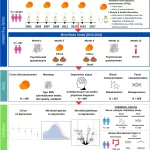A recent study published in Management Science has revealed that staggered stay-at-home orders (SHOs) played a crucial role in reducing mobility during the early stages of the COVID-19 pandemic. Conducted by economists at Johns Hopkins Carey Business School, the research highlights the significant “spillover effects” of these policies on neighboring counties.
Key Findings of the Study
The research found that SHOs reduced mobility not only in counties where they were enforced but also in geographically adjacent counties that had yet to implement such restrictions. These spillover effects accounted for a mobility reduction of about a third to a half of the decline observed in counties with SHOs.
According to Alessandro Rebucci, a professor of economics at the Carey Business School and co-author of the study, “This result is important because it opens the possibility that a staggered implementation of SHOs might have reduced mobility more than a counterfactual ‘coordinated’ implementation, very much advocated at the time by both the policy and academic community.”
Role of Media and Information Sharing
The study also highlights the impact of media coverage in shaping public behavior. Counties sharing a media market with those enforcing SHOs saw greater declines in mobility, reinforcing the role of local news in spreading awareness and influencing voluntary social distancing measures.
Directional mobility data used in the study demonstrated that decreased movement in neighboring counties played a substantial role in reducing overall travel, beyond just the decline observed within SHO-enforcing counties. This voluntary response suggests that public awareness and staggered restrictions together contributed to limiting virus transmission.
Implications for Future Pandemic Response
With infectious disease outbreaks occurring more frequently—three times more often than 40 years ago, according to the Center for Health Security at Johns Hopkins Bloomberg School of Public Health—the study offers valuable lessons for policymakers. By leveraging spillover effects through staggered SHOs and strategic communication, governments may achieve effective mobility reductions without resorting to universal lockdowns.
“Our study is the first to show that even without universal lockdowns, through staggered SHOs, Americans reached a substantial proportion of the reductions in mobility and social interactions that were mandated in some European and Asian countries,” noted Emilia Simeonova, a professor of health economics at the Carey Business School and co-author of the study.
The researchers emphasize that the timing of policy implementation is crucial. An early staggered approach, combined with robust public messaging, may yield better outcomes than a delayed, coordinated response.
Conclusion
As governments prepare for potential future pandemics, the findings from this study underscore the importance of flexible, adaptive policy measures. Understanding the indirect effects of public health interventions can aid in designing effective strategies that balance disease control with economic and social considerations.
Disclaimer: The information in this article is based on research findings and does not constitute medical or policy advice. Readers are encouraged to refer to official public health sources for guidance on pandemic management.










